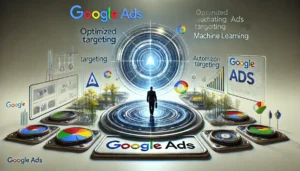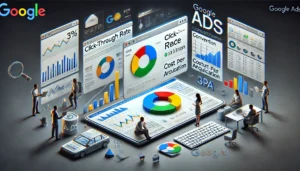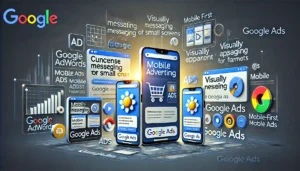Google AdWords Farewell: Mastering the New Era of Google Ads PPC for UK Businesses

Google AdWords Farewell: Mastering the New Era of Google Ads PPC for UK Businesses – As Google transitions from AdWords to Google Ads, businesses in the UK need to adapt to this change. The new platform offers exciting features and tools that can enhance online advertising efforts. This article will guide you through the key aspects of this shift, helping you to navigate the new landscape of Google Ads effectively.
Key Takeaways
- Google Ads is the rebranded version of AdWords, focusing on improved user experience.
- The transition brings new features that can boost your advertising strategies.
- Understanding the differences between AdWords and Google Ads is crucial for effective campaigning.
- Setting up your first Google Ads campaign is straightforward and user-friendly.
- Optimising your ads can significantly enhance performance and return on investment.
Google AdWords Farewell: Understanding the Transition from Google AdWords to Google Ads
The shift from Google AdWords to Google Ads marks a significant change in how we approach online advertising. This rebranding reflects a broader strategy to simplify and enhance the advertising experience.
Key Differences Between AdWords and Google Ads
While both platforms serve the same purpose, there are key differences:
- Interface: Google Ads features a more user-friendly interface.
- Features: New tools and options are available, such as optimised targeting.
- Focus: Google Ads emphasises machine learning and automation.
Reasons Behind the Rebranding (Google AdWords Farewell)
The rebranding was driven by several factors:
- Simplification: To make advertising more accessible for businesses of all sizes.
- Innovation: To incorporate advanced technologies like AI.
- Integration: To unify various advertising products under one umbrella.
Impact on Existing AdWords Campaigns
For those of us with existing Google AdWords PPC campaigns, the transition is mostly seamless. However, we should be aware of:
- Automatic Migration: Most campaigns will be migrated automatically.
- Learning Curve: Familiarising ourselves with the new features may take time.
- Support: Google provides resources to help us adapt to the changes.
As we navigate this transition, it’s essential to stay informed and embrace the new tools available to enhance our advertising strategies.
In conclusion, understanding these changes will help us leverage Google Ads effectively, ensuring our campaigns remain competitive in the evolving digital landscape.
Google AdWords Farewell: Setting Up Your First Google Ads Campaign
Starting our journey with Google Ads can be exciting yet overwhelming. Setting up your first campaign is crucial for success. Here’s how we can do it effectively:
Creating a Google Ads Account
- Visit the Google Ads website and click on “Start Now”.
- Sign in with our Google account or create a new one.
- Follow the prompts to set up our account, including selecting our time zone and currency.
Choosing the Right Campaign Type (Google AdWords Farewell)
We have several options to choose from:
- Search Campaigns: Text ads on Google search results.
- Display Campaigns: Visual ads on websites.
- Video Campaigns: Ads on YouTube.
Selecting the right type depends on our goals. For instance, if we want to reach users actively searching for our products, a Search Campaign is ideal.
Setting Your Budget and Bids
We need to decide how much we want to spend:
- Daily Budget: The maximum amount we’re willing to spend each day.
- Bidding Strategy: Choose between manual bidding or automated options.
| Budget Type | Description |
|---|---|
| Daily Budget | Amount spent per day |
| Monthly Budget | Total amount for the month |
Remember, starting with a clear budget helps us avoid overspending.
By following these steps, we can set up our first Google Ads campaign with confidence. Let’s take the plunge and start reaching our audience effectively!
Google AdWords Farewell: Optimising Your Google Ads for Better Performance
Using Keywords Effectively
To get the most out of our Google Ads, we must focus on keywords. These are the terms our potential customers are searching for. Here are some tips:
- Research relevant keywords: Use tools to find keywords that match our products or services.
- Use long-tail keywords: These are more specific and often less competitive.
- Regularly update our keyword list: Trends change, and so should our keywords.
Crafting Compelling Ad Copy (Google AdWords Farewell)
Our ad copy is crucial. It needs to grab attention and encourage clicks. Here’s how we can improve:
- Highlight unique selling points: What makes us different?
- Include a clear call to action: Tell users what we want them to do next.
- Test different versions: A/B testing can show us what works best.
Utilising Ad Extensions
Ad extensions can enhance our ads and provide more information. They can lead to higher click-through rates. We should consider:
- Sitelink extensions: Direct users to specific pages on our site.
- Call extensions: Allow users to call us directly from the ad.
- Location extensions: Help users find our physical store.
By focusing on these strategies, we can significantly improve our Google Ads performance. Optimisation is key to achieving better results and maximising our advertising budget.
In summary, optimising our Google Ads involves effective keyword usage, compelling ad copy, and leveraging ad extensions. As a PPC management team, we must stay proactive and adapt to changes in the market. This will help us achieve our goals and drive more traffic to our site, ultimately benefiting our ecommerce PPC efforts. Remember, a well-optimised can lead to better returns on our investment, especially when working with a PPC ecommerce agency.
Google AdWords Farewell: Advanced Targeting Strategies in Google Ads
Audience Targeting Options
In Google Ads, we can reach specific groups of people based on their interests and behaviours. This is known as audience targeting. Here are some options we can use:
- Remarketing: Target users who have previously visited our website.
- In-market audiences: Reach users actively searching for products or services similar to ours.
- Custom audiences: Create tailored audiences based on our own data.
Geographic and Demographic Targeting (Google AdWords Farewell)
We can also focus our ads on specific locations and demographics. This helps us connect with the right customers. For example:
- Location targeting: Show ads to users in certain countries, regions, or cities.
- Demographic targeting: Target users based on age, gender, and household income.
- Language targeting: Reach users who speak specific languages.
Remarketing Techniques
Remarketing is a powerful tool. It allows us to re-engage users who have shown interest in our products. Here are some effective techniques:
- Dynamic remarketing: Show ads featuring products users viewed on our site.
- Remarketing lists for search ads: Tailor search ads based on user behaviour.
- Email list targeting: Use our email list to reach existing customers with tailored ads.
By using these advanced targeting strategies, we can significantly improve our ad performance and reach the right audience effectively.
In conclusion, mastering these targeting options is essential for maximising our Google Ads success. We should always test and refine our strategies to see what works best for our business.
Google AdWords Farewell: Measuring Success – Google Ads Analytics and Reporting
In the world of Google Ads, understanding how to measure success is crucial for any business. Analytics and reporting provide us with the insights we need to refine our strategies and improve our campaigns.
Key Metrics to Track
To effectively gauge our performance, we should focus on several key metrics:
- Click-Through Rate (CTR): This shows how often people click on our ads after seeing them.
- Conversion Rate: This indicates the percentage of users who take a desired action after clicking on our ad.
- Cost Per Acquisition (CPA): This metric helps us understand how much we spend to acquire a customer.
Setting Up Conversion Tracking (Google AdWords Farewell)
Setting up conversion tracking is essential. It allows us to see which ads are driving valuable actions on our website. Here’s how we can do it:
- Go to the Google Ads dashboard.
- Click on the ‘Tools’ icon and select ‘Conversions’.
- Follow the prompts to set up tracking for specific actions, like purchases or sign-ups.
Using Google Analytics with Google Ads
Integrating Google Analytics with Google Ads can enhance our reporting capabilities. This integration allows us to:
- View user behaviour on our site after they click on our ads.
- Understand the full customer journey, from ad click to conversion.
- Access detailed reports that help us optimise our campaigns.
By leveraging analytics, we can make informed decisions that lead to better campaign performance.
In summary, measuring success in Google Ads is not just about tracking clicks. It’s about understanding the entire customer journey and making data-driven decisions to maximise our advertising efforts. With the right metrics and tools, we can ensure our campaigns are effective and profitable.
Additionally, we should keep an eye on new merchant reports in Google Search Console, as they can provide valuable insights for our e-commerce strategies.
Google AdWords Farewell: Maximising ROI with Smart Bidding Strategies
Understanding Smart Bidding
Smart Bidding is a game-changer for us. It uses machine learning to optimise our bids in real-time, ensuring we get the most out of our advertising budget. By automating the bidding process, we can focus on crafting better ads and targeting the right audience.
Setting Up Automated Bidding (Google AdWords Farewell)
To set up Smart Bidding, we need to follow these steps:
- Choose a bidding strategy that aligns with our goals, such as Maximise Conversions or Target CPA.
- Set our campaign goals clearly, so the system knows what we want to achieve.
- Monitor performance regularly to ensure the strategy is working effectively.
Monitoring and Adjusting Bids
It’s crucial to keep an eye on our campaigns. We should:
- Review key metrics like conversion rates and cost per acquisition.
- Adjust our strategies based on performance data.
- Test different bidding strategies to find what works best for our business.
In the world of PPC, staying adaptable is key. We must be ready to tweak our strategies as we learn more about what drives results.
| Bidding Strategy | Best For | Key Feature |
|---|---|---|
| Maximise Conversions | Increasing conversion volume | Focuses on getting the most conversions possible |
| Target CPA | Cost-effective conversions | Aims to achieve a specific cost per acquisition |
| Target ROAS | Return on ad spend | Optimises for a specific return on investment |
By leveraging Smart Bidding, we can significantly enhance our ROI and make our Google Ads campaigns more effective. Let’s embrace this technology and see the results!
Google AdWords Farewell: Leveraging Google Ads for Mobile Advertising
In today’s digital landscape, mobile advertising is crucial for reaching our audience effectively. With more users accessing the internet via mobile devices, we must adapt our strategies accordingly. Here are some key areas to focus on:
Creating Mobile-Friendly Ads
- Ensure that our ads are visually appealing on smaller screens.
- Use concise messaging that captures attention quickly.
- Test different formats to see what resonates best with our audience.
Using Call-Only Campaigns (Google AdWords Farewell)
- These campaigns are designed specifically for mobile users who prefer to call rather than click.
- We can set up ads that only allow users to call our business directly, streamlining the process.
- This is particularly effective for service-based businesses.
Optimising for Mobile Conversions
- We should focus on fast-loading landing pages that are easy to navigate on mobile devices.
- Implement clear calls to action that guide users towards conversion.
- Regularly review our mobile performance metrics to identify areas for improvement.
Mobile advertising is not just an option; it’s a necessity in our marketing strategy. By leveraging Google Ads effectively, we can enhance our reach and engagement.
In summary, as we embrace mobile advertising, we must ensure our strategies are tailored to the unique behaviours of mobile users. This will help us maximise our impact and drive better results for our campaigns.
By focusing on these strategies, we can ensure that our mobile advertising efforts are not only effective but also aligned with the latest trends in digital marketing. Let’s make the most of this opportunity!
Google AdWords Farewell: Exploring New Features in Google Ads
Responsive Search Ads
Responsive Search Ads (RSAs) are a game changer. They allow us to input multiple headlines and descriptions, and Google will automatically test different combinations to find the best-performing ads. This means we can reach our audience more effectively. The flexibility of RSAs can significantly enhance our ad performance.
Local Campaigns (Google AdWords Farewell)
Local Campaigns are designed to help businesses drive foot traffic to their physical locations. By using this feature, we can promote our business across Google’s platforms, including Maps and YouTube. This is particularly beneficial for local businesses looking to attract nearby customers.
Video Advertising on YouTube
Video ads on YouTube are becoming increasingly popular. They allow us to engage with our audience in a dynamic way. We can create short, compelling videos that capture attention quickly. This format is especially effective for storytelling and brand awareness.
| Feature | Description | Benefits |
|---|---|---|
| Responsive Search Ads | Automatically tests ad combinations | Improved performance |
| Local Campaigns | Promotes physical locations across Google platforms | Increased foot traffic |
| Video Advertising | Engaging video ads on YouTube | Enhanced brand storytelling |
In summary, these new features in Google Ads provide us with powerful tools to enhance our advertising strategies.
By embracing these innovations, we can ensure our campaigns remain competitive and effective.
In addition, conducting a Google ads audit can help us identify areas for improvement and maximise our advertising efforts.
Let’s explore these features further and see how they can benefit our specific business needs!
Google AdWords Farewell: Common Pitfalls and How to Avoid Them
In our journey with Google Ads, we often encounter several common pitfalls that can hinder our success. Recognising these issues early can save us time and money. Here are some of the most frequent mistakes we should be aware of:
Overcoming Ad Fatigue
- Ad fatigue occurs when our audience sees the same ads too often, leading to decreased engagement. To combat this, we can:
- Rotate our ads regularly.
- Test new creatives and messages.
- Monitor performance metrics closely.
Avoiding Click Fraud (Google AdWords Farewell)
Click fraud can drain our budgets without delivering real results. We can protect ourselves by:
- Using click fraud detection tools.
- Regularly reviewing our traffic sources.
- Setting up IP exclusions for suspicious activity.
Managing Budget Effectively
A well-planned budget is crucial for success. Here’s how we can manage it:
- Set clear goals for our campaigns.
- Allocate budgets based on performance data.
- Adjust bids regularly to maximise our return on investment.
| Pitfall | Solution |
|---|---|
| Ad Fatigue | Rotate ads and test new creatives |
| Click Fraud | Use detection tools and review traffic |
| Budget Management | Set goals and adjust bids regularly |
By being aware of these pitfalls, we can navigate the complexities of Google Ads more effectively. Let’s stay proactive and informed!
Google AdWords Farewell: Future Trends in Google Ads
As we look ahead, the landscape of Google Ads is evolving rapidly. The integration of AI and machine learning is set to redefine how we approach advertising. These technologies will help us create more effective campaigns by analysing vast amounts of data to predict user behaviour.
The Role of AI and Machine Learning
- AI will automate many tasks, making it easier for us to manage campaigns.
- Machine learning algorithms will optimise ad placements and targeting.
- Predictive analytics will allow us to anticipate trends and adjust strategies accordingly.
Privacy and Data Protection (Google AdWords Farewell)
With increasing concerns about privacy, we must adapt our strategies. Google is focusing on privacy-centric advertising, which means:
- Enhanced user consent protocols.
- More transparent data usage policies.
- New tools for advertisers to comply with regulations.
Emerging Ad Formats
The introduction of new ad formats will also shape our future strategies. We can expect:
- Performance Max campaigns that optimise across multiple channels.
- Video ads becoming more prevalent, especially on platforms like YouTube.
- Interactive ads that engage users in new ways.
As we embrace these changes, it’s crucial to stay informed and agile. The future of Google Ads is bright, and with the right strategies, we can maximise our success in this new era.
As we look ahead, Google Ads is set to evolve in exciting ways. With new features and smarter targeting options, businesses can connect with their audience more effectively than ever. Don’t miss out on these opportunities! Visit our website today to get a free review of your Ads performance and see how we can help you succeed!
Conclusion
As we bid farewell to Google AdWords, it’s clear that the shift to Google Ads marks a significant change for businesses in the UK. This new platform offers exciting tools and features that can help you reach your audience more effectively. By embracing these changes and adapting your strategies, you can thrive in this new advertising landscape. Remember, the key to success lies in understanding your audience and making the most of the resources available. With the right approach, your business can not only survive but flourish in this evolving digital world.
Frequently Asked Questions
What is the main difference between Google AdWords and Google Ads?
Google AdWords has been renamed to Google Ads. The new name reflects a broader range of advertising options beyond just search ads.
Why did Google decide to rebrand AdWords?
The rebranding to Google Ads was made to simplify the advertising experience and to include more types of advertising services.
Will my existing AdWords campaigns be affected by this change?
Your current AdWords campaigns will continue to run without interruption, but you may need to adapt to new features in Google Ads.
How do I create a Google Ads account?
To create a Google Ads account, visit the Google Ads website and follow the prompts to set up your account.
What types of campaigns can I run with Google Ads?
Google Ads offers various campaign types, including search ads, display ads, video ads, and shopping ads.
How can I optimise my Google Ads for better results?
You can optimise your Google Ads by using relevant keywords, writing engaging ad copy, and making use of ad extensions.
What is smart bidding in Google Ads?
Smart bidding is an automated bidding strategy that uses machine learning to optimise for conversions or conversion value.
Are there any new features in Google Ads I should know about?
Yes, Google Ads has introduced features like responsive search ads and local campaigns that can help enhance your advertising efforts.
Author
Search Blog
Free PPC Audit
Subscribe to our Newsletter
The Voices of Our Success: Your Words, Our Pride
Don't just take our word for it. With over 100+ five-star reviews, we let our work-and our satisfied clients-speak for us.
"We have been working with PPC Geeks for around 6 months and have found Mark and the team to be very impressive. Having worked with a few companies in this and similar sectors, I rate PPC Geeks as the strongest I have come across. They have taken time to understand our business, our market and competitors and supported us to devise a strategy to generate business. I value the expertise Mark and his team provide and trust them to make the best recommendations for the long-term."
~ Just Go, Alasdair Anderson




